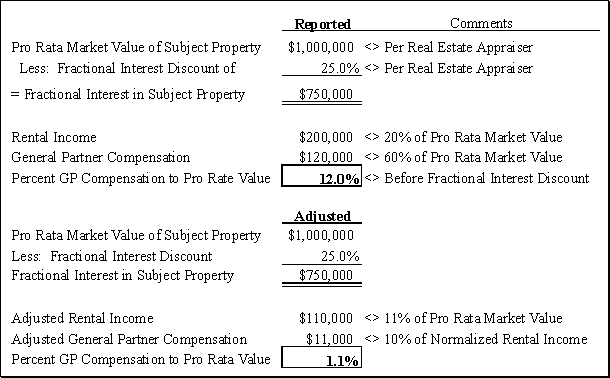Is It Reasonable? Normalizing Adjustments
Asset-holding entities are typically partnerships or limited liability companies with assets that include some combination of real estate, marketable securities, and/or closely held securities. As part of the appraisal due diligence process, information is obtained from general partners and/or managing members as well as from a variety of other sources (generally attorneys, real estate appraisers, accountants, securities brokers, and industry contacts). Such information provides a basis for the appraiser to understand the composition, operations, strategy, and governance of the entity. This article focuses on the importance of analyzing, from a valuation perspective, the reasonableness of this information.
When information fails to reconcile with industry or circumstantial norms, or appears unreasonable or lacking in common sense, appraisers may need to make “normalizing” adjustments. These adjustments attempt to modify reported facts and circumstances to conform to the standard of fair market value. Under the standard of fair market value, the financial characteristics of the valuation subject must make sense and be reasonably representative of the considerations of hypothetical investors.
A hypothetical asset-holding entity can illustrate the concepts. At issue in the example are the reasonableness of the general partner’s compensation and the reasonableness of rental income paid to a limited partnership.
Overview of the Hypothetical Asset-Holding Entity
The hypothetical asset-holding entity is a limited partnership with assets consisting primarily of a fractional interest in a commercial building. The property houses a chain retailer in potentially serious financial difficulty as of the valuation date. The property was appraised and the appraisal took into account the partnership’s fractional interest by applying a 25% fractional interest discount.
General Partner’s Compensation
Approximately 60% of the partnership’s current total income (mostly rent) is being paid as compensation to the general partner. In addition to overseeing the management of the partnership, the general partner essentially acted as a property manager. According to our research, industry rates for property management fees generally range from approximately 6% to 11% of collected rents, which is much lower than the 60% the hypothetical general partner is receiving in this scenario. Is this level of compensation reasonable? The answer requires further clarification regarding the amount of the partnership’s rental income.
Rental Income
An analysis of the partnership’s reported asset values and revenue implies a 20% capitalization rate on annual rental income. Typically, capitalization rates on properties of this nature range from 11% to 15%. Either the rental income is unusually high or the appraisal is potentially flawed by understating the value of the property.
Adjustments
Ultimately, the income and expense profile related to this property affects our analysis of a limited partner’s expected liquidity resulting from distributions. This, in turn, affects the magnitude of the marketability discount. As appraisers, we have to reconcile the facts from the perspective of a reasonable investor’s long-term expectation. The questions we must address are: (1) what is a reasonable and sustainable level of future rental income? and (2) what is a reasonable level of compensation for the general partner?
After conversations with several real estate appraisers, a capitalization rate of 11% was applied to the appraised market value of the subject property (pro rata, exclusive of the fractional interest discount). This provides us with a reasonable and sustainable level of rental income on the property. Correspondingly, we believe that a rational investor would anticipate a lower level of general partner compensation. Such compensation should likely be based on traditional property management rates.
Using the normalized rental income described above, we believe that the general partner should be compensated at approximately 10% of collected rents. Such compensation also reflects the general partner’s administration of the entity’s overall business.
In Table 1, note that the adjustments applied in this case result in a difference of nearly 11% of asset value. The resulting cash flow would make a potentially significant difference in the growth of the partnership’s assets or to the funds available for distribution. Both of these aspects are crucial to the development of an appropriate marketability discount for the valuation of a limited partner interest.
Why Normalizing Adjustments Should Be Made
A limited partner has virtually no control over such things as the management, distribution of cash flows, and investment strategy of the partnership. However, fair market value is defined as the price at which a hypothetical willing buyer and a hypothetical willing seller, both of whom are fully informed, neither of whom is under any compulsion, and both of whom have the capacity to engage in a transaction. Any hypothetical investor would anticipate a “normalized” level of income and a corresponding level of general partner compensation based on some industry norm.
Normalizing adjustments reveal the true investment characteristics that are the source of “potential value” to buyers of minority interests. When minority interests are purchased, investment judgments are made based upon how and when this potential value might ultimately be realized. Based on the timing and the amount of expected returns on illiquid minority interests, appraisers develop marketability discounts that are sufficient enough to consummate the hypothetical transaction.
It can be argued that because limited partners (or other similar minority investors) lack control to change things like general partner compensation or to negotiate property leases, normalizing adjustments should not be made. However, keep in mind that minority shareholders of public companies lack this discretionary ability as well. If unusual activity is occurring on the income statement, minority shareholders of the public company will find alternative investments and the price of the public company’s stock will eventually reflect this.
Conclusion
Information should not be taken at face value. It must be examined and reconciled to a standard of reasonableness, common sense, and informed judgment. Our hypothetical partnership illustrates the importance of understanding the numbers and the necessity of normalizing adjustments.
Reprinted from Mercer Capital’s Value AddedTM – Vol. 12, No. 3, 2000.


